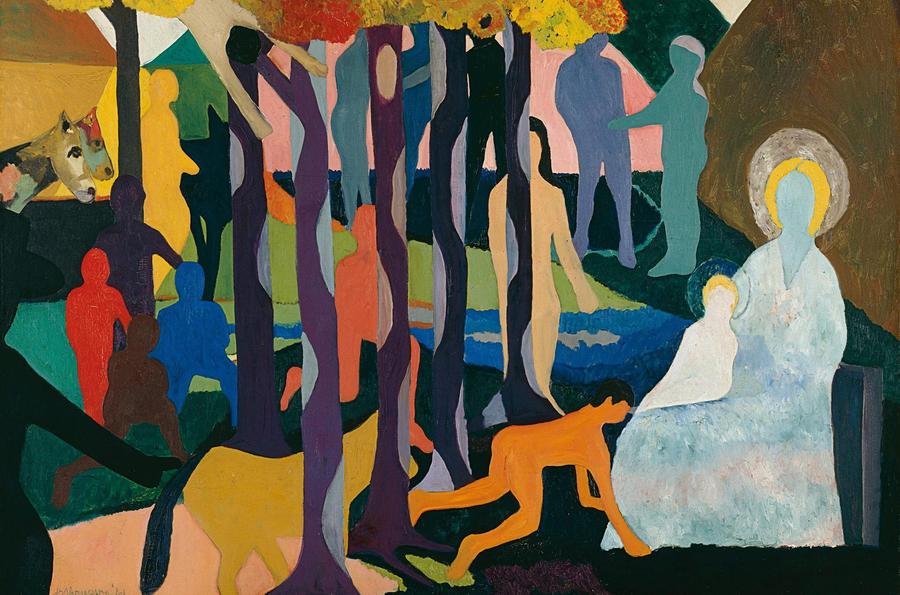

"All this was totally my imagination of a faraway place." - Bob Thompson
An important traveling exhibition offers a rich reconsideration of a visionary African American painter. Born in Louisville, Kentucky, Bob Thompson (1937–1966) earned critical acclaim in the late 1950s for his paintings of figurative complexity and chromatic intensity. Bob Thompson: This House Is Mine borrows its name from a diminutive but exquisite painting created by the artist in 1960. With this title, Thompson declared his ambition to synthesize a new visual language out of elements of historic European painting.
Bob Thompson: This House Is Mine is organized by the Colby College Museum of Art in Waterville, Maine, and will travel after debuting at Colby (on view now through January 9, 2022) to: Smart Museum of Art, The University of Chicago, Chicago, February 10–May 15, 2022; High Museum of Art, Atlanta, June 18–September 11, 2022; Hammer Museum at UCLA , Los Angeles, October 9, 2022–January 8, 2023.
The first museum exhibition devoted to the artist in more than twenty years, This House Is Mine traces Thompson’s brief but prolific transatlantic career, examining his formal inventiveness and his engagement with universal themes of collectivity, bearing witness, struggle, and justice. Over a mere eight years, he grappled with the exclusionary Western canon, developing a lexicon of enigmatic forms that he threaded through his work. Human and animal figures, often silhouetted and relatively featureless, populate mysterious vignettes set in wooded landscapes or haunt theatrically compressed spaces. Thompson reconfigures well-known compositions by European artists such as Piero della Francesca and Francisco de Goya through brilliant acts of formal distortion and elision, recasting these scenes in sumptuous colors. On occasion, familiar individuals appear: the jazz greats Nina Simone and Ornette Coleman, and the writers LeRoi Jones (later Amiri Baraka) and Allen Ginsberg.

Bringing together paintings and works on paper from more than fifty public and private collections across the United States, This House Is Mine centers Bob Thompson’s work within expansive art historical narratives and ongoing dialogues about the politics of representation, charting his enduring influence. The exhibition is accompanied by a lavishly illustrated catalogue featuring scholars, artists, and poets, published in association with Yale University Press.
Robert Louis (Bob) Thompson briefly studied medicine at Boston University before enrolling in the studio program at the University of Louisville, which had desegregated in 1951. As an art student, Thompson explored the languages of totemic abstraction then in vogue and developed an extraordinary proficiency in academic drawing. He spent the summer of 1958 in Provincetown, Massachusetts, where he continued his training at the Seong Moy School of Painting and Graphic Arts and forged valuable friendships. Thompson also encountered the work of the recently deceased German émigré artist Jan Müller (1922–1958), whose figurative style pointed him toward new expressive possibilities.

Thompson soon settled in New York City, where he joined fellow artists Allan Kaprow and Red Grooms in some of their first so-called “Happenings,” multimedia performance events. A devotee of jazz, Thompson frequented downtown clubs such as Slugs’ Saloon and the Five Spot Café, where legendary performers including Ornette Coleman, John Coltrane, and Charlie Haden played. These musicians materialize in many of Thompson’s paintings and drawings including Ornette (Birmingham Museum of Art, 1960–61) and Garden of Music (Wadsworth Atheneum Museum of Art, 1960). This pivotal period was marked by Thompson’s first solo New York City exhibition, and within the next few years his work entered some of the preeminent modern art collections in the United States.
In 1961, Thompson and his wife, Carol, made their first trip to Europe together, spending time in London and Paris and eventually settling in Ibiza. Thompson was able to fully immerse himself in the traditions that formed the core of his practice. While in Spain, he deepened his study of Francisco de Goya (1746–1828), and canvases such as Untitled (Colby College Museum of Art, 1962) demonstrate his heady dialogue with Los Caprichos, the Spanish artist’s mordantly satirical print series. On a second trip to Europe, the couple settled in Rome, where Thompson died tragically on May 30, 1966, of complications following gall bladder surgery.
Memorial exhibitions at the New School for Social Research (1969) and the Speed Art Museum (1971) celebrated his life and career. In 1998, Thelma Golden and Judith Wilson mounted a foundational scholarly retrospective of his work at the Whitney Museum of American Art. More recently, paintings by Thompson have featured in group exhibitions such as Witness: Art and Civil Rights in the Sixties; The Color Line: African-American Artists and Segregation; and Soul of a Nation: Art in the Age of Black Power. The Estate of Bob Thompson is represented by Michael Rosenfeld Gallery.

No comments:
Post a Comment